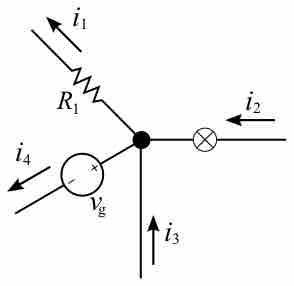Kirchhoff's junction rule, also known as Kirchhoff's current law (KCL), Kirchoff's first law, Kirchhoff's point rule, and Kirchhoff's nodal rule, is an application of the principle of conservation of electric charge.
Kirchhoff's junction rule states that at any junction (node) in an electrical circuit, the sum of the currents flowing into that junction is equal to the sum of the currents flowing out of that junction. In other words, given that a current will be positive or negative depending on whether it is flowing towards or away from a junction, the algebraic sum of currents in a network of conductors meeting at a point is equal to zero. A visual representation can be seen in .

Kirchhoff's Junction Law
Kirchhoff's Junction Law illustrated as currents flowing into and out of a junction.
Thus, Kirchoff's junction rule can be stated mathematically as a sum of currents (I):
where n is the total number of branches carrying current towards or away from the node.
This law is founded on the conservation of charge (measured in coulombs), which is the product of current (amperes) and time (seconds).
Limitation
Kirchhoff's junction law is limited in its applicability. It holds for all cases in which total electric charge (Q) is constant in the region in consideration. Practically, this is always true so long as the law is applied for a specific point. Over a region, however, charge density may not be constant. Because charge is conserved, the only way this is possible is if there is a flow of charge across the boundary of the region. This flow would be a current, thus violating Kirchhoff's junction law.